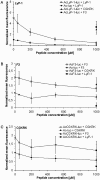Enhanced baculovirus-mediated transduction of human cancer cells by tumor-homing peptides
- PMID: 16775347
- PMCID: PMC1488948
- DOI: 10.1128/JVI.00528-06
Enhanced baculovirus-mediated transduction of human cancer cells by tumor-homing peptides
Abstract
Tumor cells and vasculature offer specific targets for the selective delivery of therapeutic genes. To achieve tumor-specific gene transfer, baculovirus tropism was manipulated by viral envelope modification using baculovirus display technology. LyP-1, F3, and CGKRK tumor-homing peptides, originally identified by in vivo screening of phage display libraries, were fused to the transmembrane anchor of vesicular stomatitis virus G protein and displayed on the baculoviral surface. The fusion proteins were successfully incorporated into budded virions, which showed two- to fivefold-improved binding to human breast carcinoma (MDA-MB-435) and hepatocarcinoma (HepG2) cells. The LyP-1 peptide inhibited viral binding to MDA-MB-435 cells with a greater magnitude and specificity than the CGKRK and F3 peptides. Maximal 7- and 24-fold increases in transduction, determined by transgene expression level, were achieved for the MDA-MB-435 and HepG2 cells, respectively. The internalization of each virus was inhibited by ammonium chloride treatment, suggesting the use of a similar endocytic entry route. The LyP-1 and F3 peptides showed an apparent inhibitory effect in transduction of HepG2 cells with the corresponding display viruses. Together, these results imply that the efficiency of baculovirus-mediated gene delivery can be significantly enhanced in vitro when tumor-targeting ligands are used and therefore highlight the potential of baculovirus vectors in cancer gene therapy.
Figures







References
-
- Airenne, K. J., M. O. Hiltunen, M. P. Turunen, A. M. Turunen, O. H. Laitinen, M. S. Kulomaa, and S. Yla-Herttuala. 2000. Baculovirus-mediated periadventitial gene transfer to rabbit carotid artery. Gene Ther. 7:1499-1504. - PubMed
-
- Arap, W., R. Pasqualini, and E. Ruoslahti. 1998. Cancer treatment by targeted drug delivery to tumor vasculature in a mouse model. Science 279:377-380. - PubMed
-
- Baker, A. H., A. Kritz, L. M. Work, and S. A. Nicklin. 2005. Cell-selective viral gene delivery vectors for the vasculature. Exp. Physiol. 90:27-31. - PubMed
-
- Barsoum, J., R. Brown, M. McKee, and F. M. Boyce. 1997. Efficient transduction of mammalian cells by a recombinant baculovirus having the vesicular stomatitis virus G glycoprotein. Hum. Gene Ther. 8:2011-2018. - PubMed
Publication types
MeSH terms
Substances
LinkOut - more resources
Full Text Sources
Other Literature Sources
Miscellaneous

